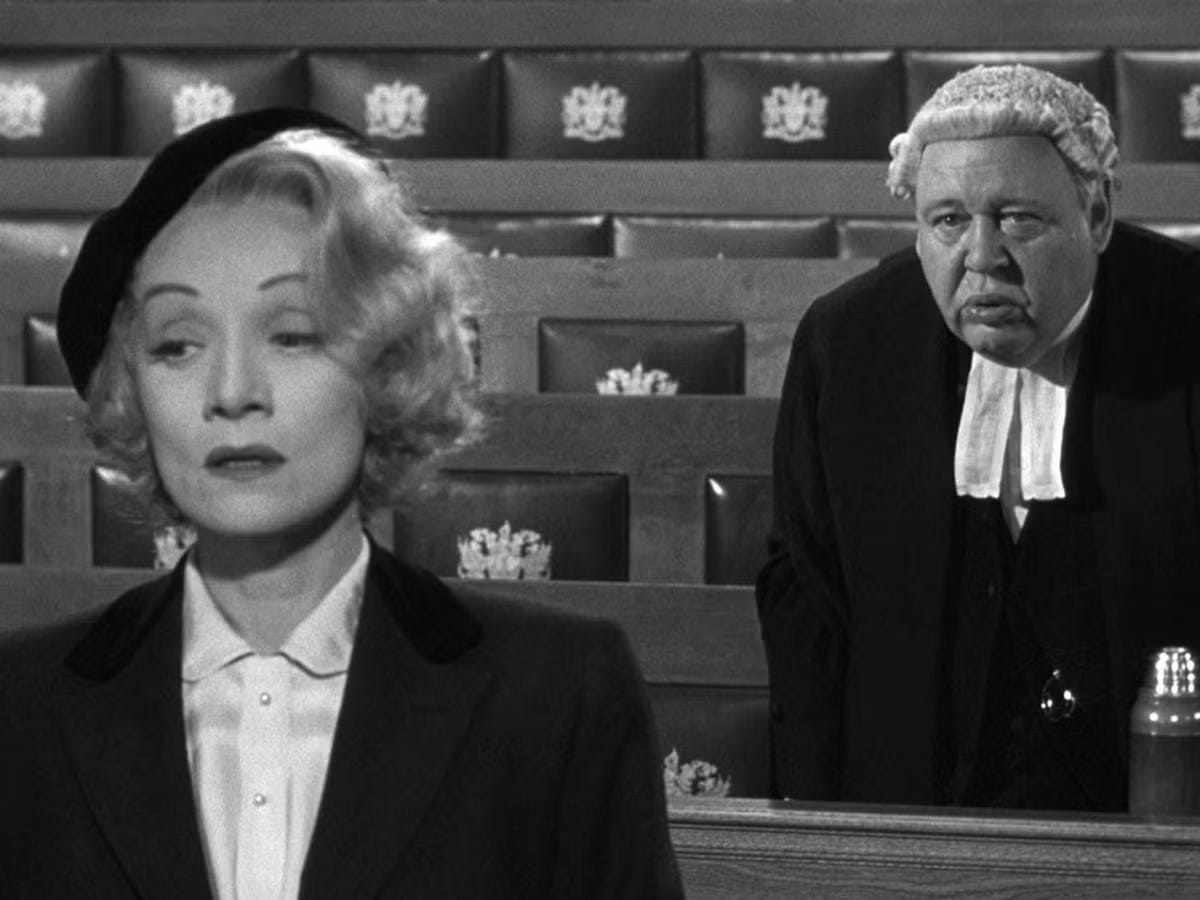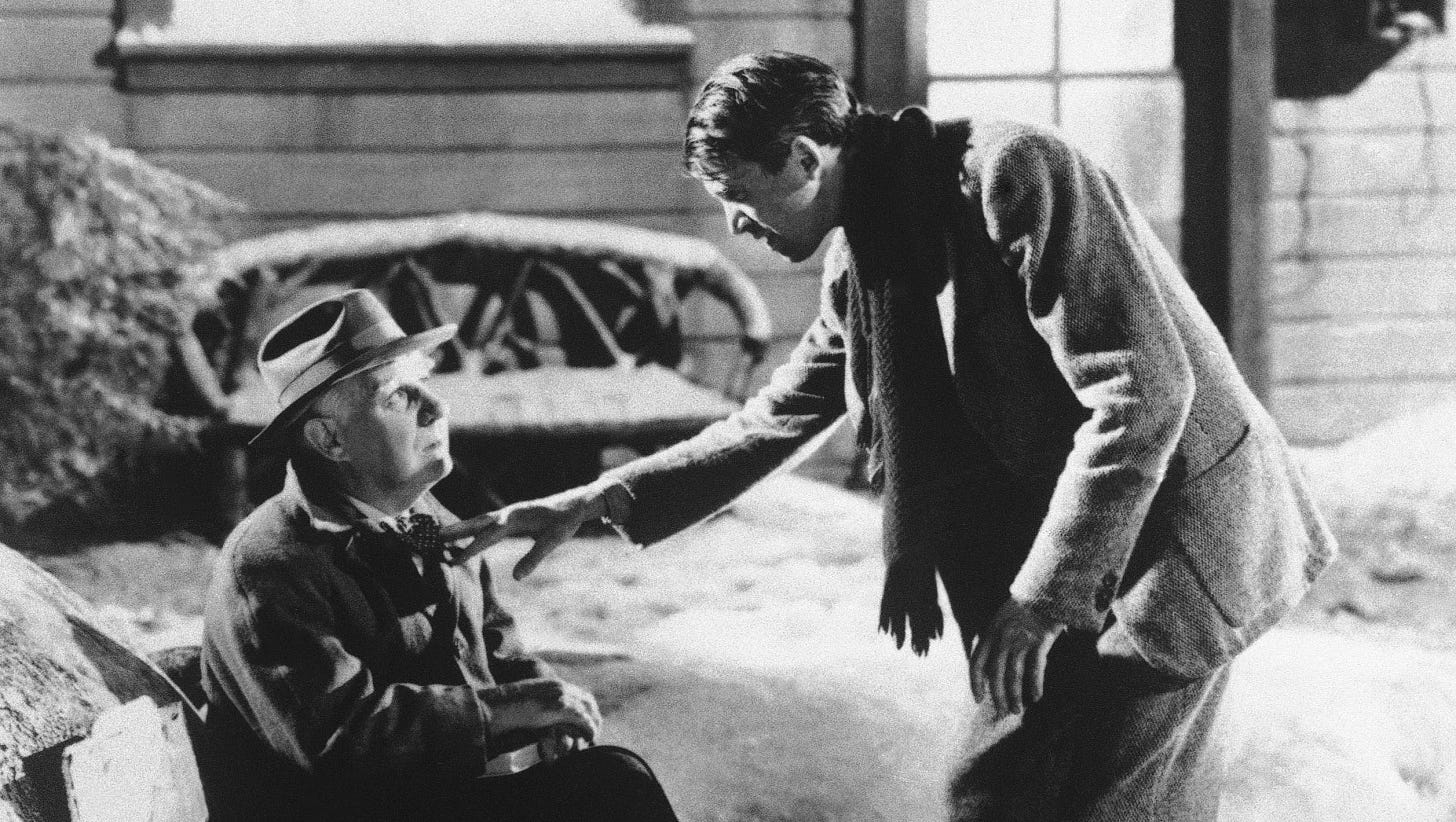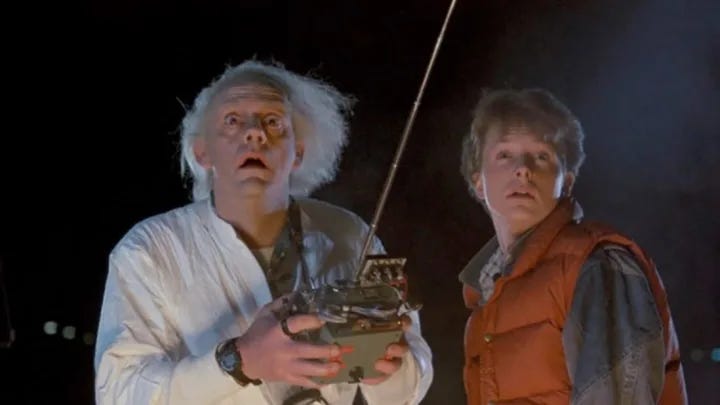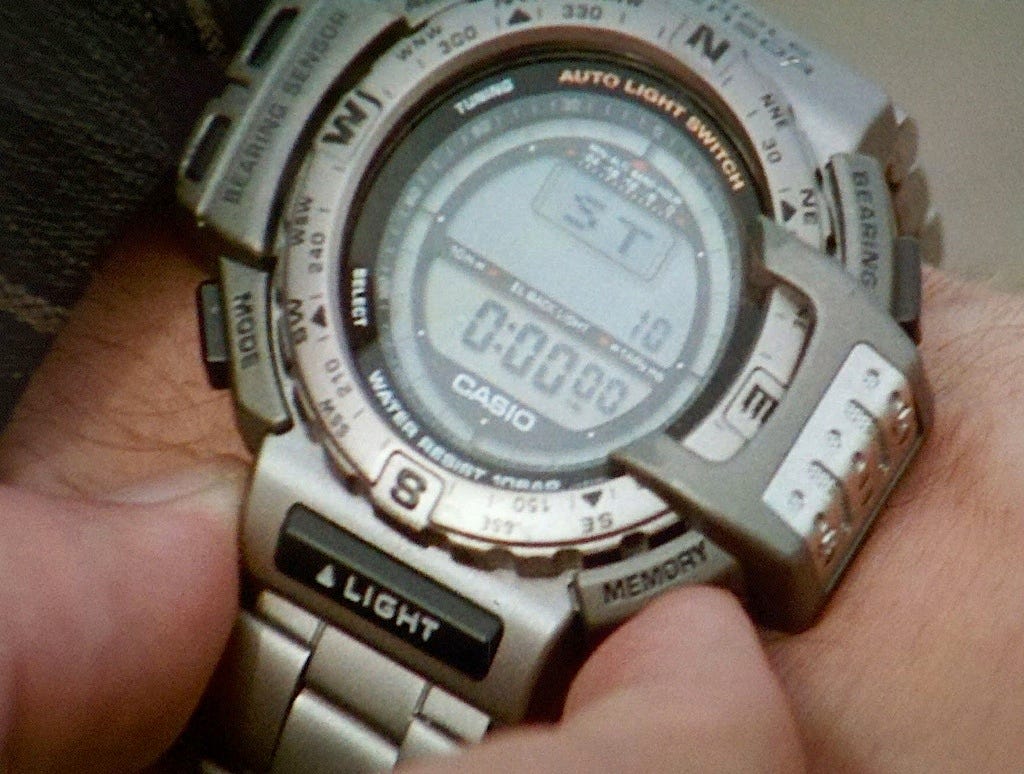I was chatting with my sister last week, who mentioned she’d just watched Witness for the Prosecution for the first time - a movie I haven’t seen, but I’m sure I’ll get to it - and she mentioned that it was somewhat belabored by today’s standards in terms of how its twist unfurls.
Apologies if this image is a spoiler - I’ve never seen Witness for the Prosecution
It got me thinking about how, as movies have evolved, and moviegoers’ understanding of them has (mostly) evolved with them, getting a character on board with their overall situation is usually a much quicker process.
Take, for instance, George Bailey’s refusal to engage with the test Clarence has put him through; George doesn’t deny that he’s witnessing Bedford Falls without his influence so much as he fails to understand that that’s what he’s witnessing, despite Clarence’s repeated patient explanations of the premise.
This goes beyond Joseph Campbell’s “call refused” - this is “call rejected, call repeated, call rejected, call sent to voicemail.”
By contrast, nearly 40 years after Clarence finally got through to George, Marty McFly’s comprehension of his circumstance boils down to a few short confused beats as he arrives in 1955 paired with his growing understanding that Doc wasn’t just talking shit back in the mall parking lot.
Marty grasps the conceit more quickly than George does because movies were forty years older as a medium, and audiences were better trained to grasp conceits along with him. Plus, if Doc’s lecture and how it immediately reshapes Marty’s life had gone over audiences’ heads, by 1985, there was the safety net of catching it some months later on home video.
Frank Capra had to make sure the audience for It’s a Wonderful Life was on board with the conceit of Clarence’s experiment because in 1946 - and for many years after - it stood to reason that when you saw a movie, that was the one time you’d see that movie.
I was born in the mid-70s, so when my family got a VCR - earlyish in their availability on the market - I was still young enough that, for me, the lifespan of a movie began in theaters, and ended (or rather, continued) months-to-years later on home video. I don’t recall a time when seeing a movie in a theater was technically precious because it was, in all likelihood, your one chance to see that movie (until years later when, as my sister pointed out, your kids bought you a VCR and a copy of It’s a Wonderful Life or Witness for the Prosecution on VHS).
By that light, it’s no wonder that decades of everything from restaurant walls to tchotchke shelves to shower curtains were bedecked with Humphrey Bogart or Marilyn Monroe or Elvis Presley or Judy Garland - anything to recapture even a fraction of the feeling of watching them that one precious time, which must have felt like trying to hold water in a cupped palm.
This is the notion that landed on me while chatting with my sister - that desire to stop or reverse the hourglass to live in a larger-than-life moment even as it slipped past you. It brought me to the finale of Cinema Paradiso, the awe and ache and glory playing in Salvatore’s eyes as he watches the forbidden fruits gifted by his mentor Alfredo from beyond the grave.
I told my sister I’d just rewatched Cinema Paradiso a few months ago (right after watching its iconic ending co-opted/paraphrased/inflated for Babylon), and was surprised at how briskly-paced it was, compared to my memory of it.
We reflect on movies at the speed of thought, our contemplation stretching what might be seconds into minutes, minutes into hours, hours into lifetimes. I don’t know about you, but for me, when I rewatch a movie I’ve dedicated all manner of my own time to thinking about, it invariably feels fast and short.
And that, friends, is a substantial preamble to what I’m here to talk about: rebooting this barely-begun substack to have a bit of focus. When I started this substack a few months ago, I didn’t really know what I wanted to do with it apart from “spend more time writing about thinking about things” and “spend less time on Twitter.” (I later deactivated my Twitter account, so in that regard, I guess it worked). But all this talk about the time-dilation involved in contemplating the things we love got me thinking about the abundance of instances where just a few minutes in the course of a piece of art can be pivotal to the point of transformative.
As all of these thoughts clicked together like so many tetrii, I was reminded of the first time I got genuinely granular in my thinking - an assignment in my Intro to Film class where we had to storyboard and analyze a sequence in a movie. This, by the way, was maybe my favorite school assignment of all time, not least because it involved watching a movie, and then talking about the movie you watched, but for course credit.
We had to clear our sequence of choice with our professor, so I chose, and got the greenlight to cover, the mall chase from Terminator 2, starting from John’s flight into the service corridor, including the switcheroo that, this time, the T-800 is a protector not an assassin, the first reveal of the T-1000’s capabilities, and ending with the T-800 and the T-1000 crashing through the back wall of a menswear boutique.
Now: without going to youtube or your T2 blu-ray, going solely on your memory of it: how long, ballpark, do you recall this sequence being? Once you have a figure in mind, scroll past the pic below for the answer.
It’s one minute, forty-seven seconds. This sequence (had the marketing for T2 not revealed any inkling of the T-1000’s chemical makeup or the T-800’s face-turn, but whatcha gonna do, you’ve got a movie to sell, you’ve gotta sell that movie) reverses seven years of narrative expectation, and raises (by an order of magnitude) the ceiling of what an audience can expect from visual effects, and it accomplishes all of that in a few seconds less than it takes to listen to “Fell In Love With a Girl.”
Of course, my freshman year deep-dive of it was several pages of storyboards (largely traced from the invaluable T2 Illustrated Screenplay, this being years before the advent of screencaps) and even more pages of text, for which my professor zealously graded me at 104%. (He then went on to become a rabid internet antivaxxer, but I like to think his judgment on film exegeses is Swiss-accurate).
Which brings me to the end of my second preamble, where I’ll finally discuss what we’re doing here. In the posts that follow, I’ll be dissecting, diagnosing, analyzing, eulogizing, and proselytizing about what I consider to be pivotal art - a scene, a song, a lived experience - which might seem near-infinite while you’re experiencing it or reflecting on it, but which is actually quite compact - fleeting, even - in realtime.
Friends, welcome to Five Great Minutes.
Note: the subjects of these posts won’t be exactly five minutes long - some will be longer, some shorter, e.g. above re: T2’s pivotal minute-forty-seven - but rather will be a discussion-worthy microcosm.
I hope you’ll join me. Something tells me if you’ve read this far, then my going subatomic on the minutia of a moment you wish could last isn’t not your cup of tea.










